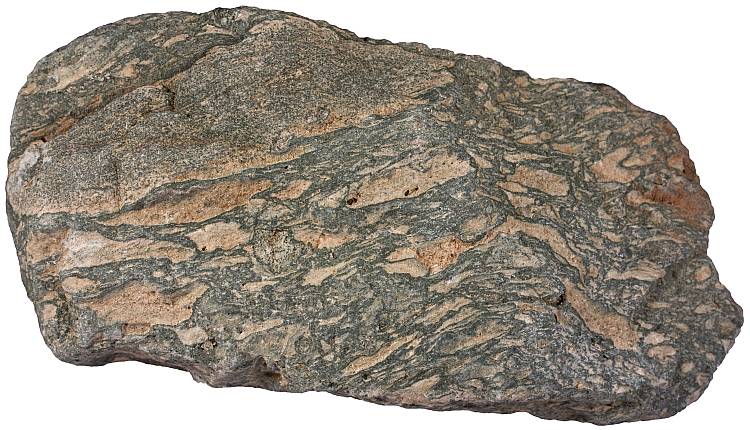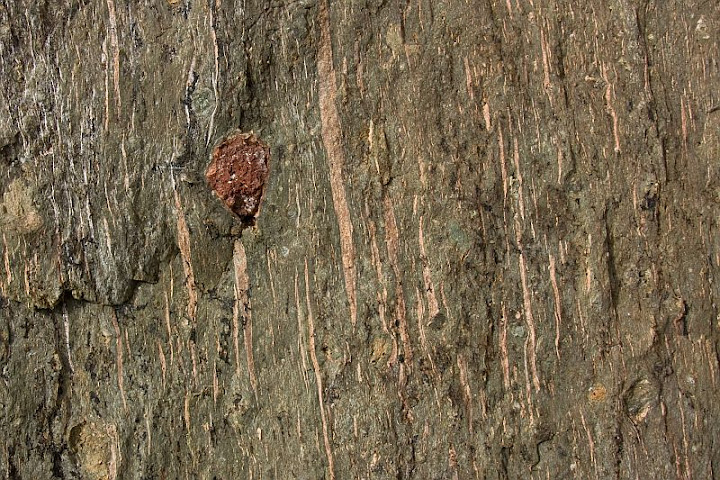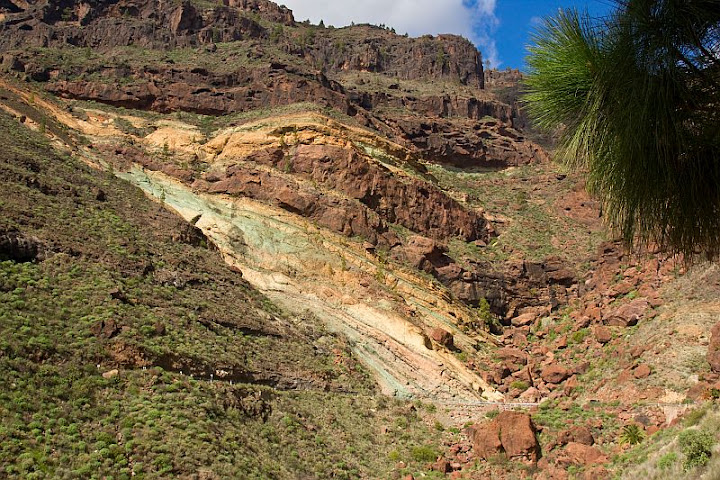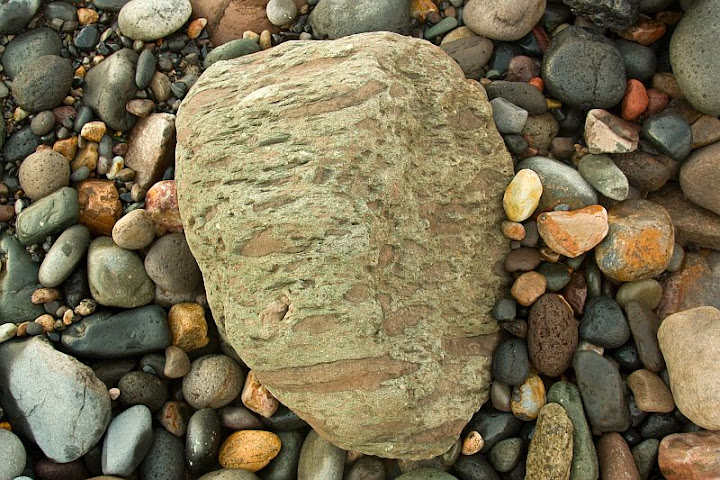Ignimbrite is a pyroclastic rock formed by very hot ground-hugging cloud of volcanic ash, blocks, and gases known as pyroclastic flow or pyroclastic density current. Ignimbrite is synonymous with flood tuff, welded tuff, ash-flow tuff and pyroclastic flow deposit1.

Rheomorphic welded ignimbrite from Gran Canaria. “Rheomorphic” means that the rock mass was able to flow in a ductile manner after the deposition. Light-colored elongated clasts are pumice fragments that were flattened and stretched by the mass of the overlying hot rocks, high temperature, and ductile flow. Such elongated pumice fragments are common in this rock. They are known as fiamme (Italian for “flames”). Width of sample 9 cm.
The term “ignimbrite” was coined by the New Zealand geologist Patrick Marshall in 1935. This term was originally used only to refer to welded tuffs. These are pyroclastic rocks that were so hot right after the deposition from the pyroclastic cloud that individual clasts adhered to each other. However, this restriction no longer applies. This term includes all pyroclastic flow deposits, no matter whether they are welded or not1.

Pyroclastic flow running down the flank of Mayon in the Philippines during the eruption of 1984. Photo courtesy of USGS.
Pyroclastic flows are the most deadly expressions of volcanism2. They are associated with explosive volcanism. Ignimbrite formations are highly variable in bulk volume (0.1 to over 1000 km3) and runout distance (1 to over 100 km)3. Their appearance is variable too. Many colors are possible and they may be unwelded which makes it hard to distinguish some ignimbrites from tuff. Its deposits are frequently hydrothermally altered. The water needed for that may come from former lakes and rivers that got buried beneath the fiery cloud. Hydrothermally altered ignimbrite is often beautifully colorful. Smaller deposits are associated with former river channels because pyroclastic flows are gravity-controlled and therefore tend to follow the valleys. Larger pyroclastic flows do not care much about topography. They just cover former valleys with thicker and highlands with thinner deposits.
Whether ignimbrite is welded or not depends mostly on the temperature in the deposit right after the deposition. Most ignimbrites tend to be felsic, although basaltic varieties are known as well. Felsic ignimbrites tend to weld if the temperature is at least 500 to 650°C. Temperature within pyroclastic flows may reach even 1000 degrees. It is no wonder that they are so deadly given also the speed at which they move (up to 700 km/h).
Well-known huge ignimbrite deposits are Bishop Tuff in western USA and Taupo ignimbrite in New Zealand. Large part of the post-erosional rocks in Gran Canaria are also ignimbrites.
Ignimbrites are composed of pumice and scoria (highly vesicular and often glassy volcanic rocks). Sometimes larger volcanic blocks are included, but most of the material ignimbrite is composed of are lapilli and ash.

Ignimbritic coastal cliff in Gran Canaria. Southern coast of Gran Canaria.

Close-up of the same outcrop reveals that it contains strongly flattened pumice fragments (fiamme). One reddish clast with a more mafic composition is also somewhat deformed but noticeably less than pumice. It is so because pumice is highly vesicular and therefore compressible. Welding temperature for felsic pumice is also lower than it is for mafic rocks which have higher melting temperatures. Up is to the left. Width of view 30 cm.

Block-and-ash flow deposit is a small volume pyroclastic flow deposit that contains large amounts of juvenile volcanic blocks. Block-and-ash flows are generally created by the collapse and fragmentation of volcanic domes2. Northern coast of Gran Canaria. Width of view 2 m.

Ignimbrite can be very beautiful. Width of view 12 cm. Western part of Gran Canaria.

Hydrothermally altered sequence of ignimbrite in the western part of Gran Canaria. Chlorite is probably responsible for the green and hematite for the reddish coloration.

Ignimbrite from Gran Canaria. Width of view 20 cm.

Ignimbrite from the NE coast of Gran Canaria. Width of view 20 cm.

Boulder of ignimbrite on the western coast of Gran Canaria.

Ignimbrite is used as a building stone in Gran Canaria.

Another wall in Gran Canaria made of ignimbrite.
References
1. Tilling, Robert I. (2007). Ignimbrite. In: McGraw Hill Encyclopedia of Science & Technology, 10th Edition. McGraw-Hill. Volume 9. 20-21.
2. Schmincke, Hans-Ulrich (2005). Volcanism. Springer.
3. Freundt, A. & Wilson, C. J. N. & Carey, S. N. (1999). Ignimbrites and Block-And-Ash Flow Deposits. In: Encyclopedia of Volcanoes (Ed. Sigurdsson, H.). Academic Press. 581-599.
Nice!
Do I see an angular unconformity in your #7 photo? (“Hydrothermally altered sequence…”). The beds in the lower 2/3 of the photo are dipping strongly to the right, and seem to be truncated by the golden brown bed, then everything above that is more-or-less flat lying. Or is it a trick of the perspective?
It is not a trick of perspective. The morphology of this exposure is indeed strange but I do not know anything certain about that. Maybe this ignimbrite sequence filled a former topographic low (river valley). That’s why it is tilted and seems to be thicker in the lower part and is also the reason why it has such a nice set of colors (evaporated river provided water for the alteration right after the deposition). There are no tectonic compressive forces that can cause angular unconformities. I would be careful with such explanations but again I am only theorizing. Such an outcrop would be a nice topic for someone’s MSc thesis.
Correction:
The term ignimbrite was coined by my grandfather New Zealand Geologist Dr PATRICK Marshall NOT Peter!